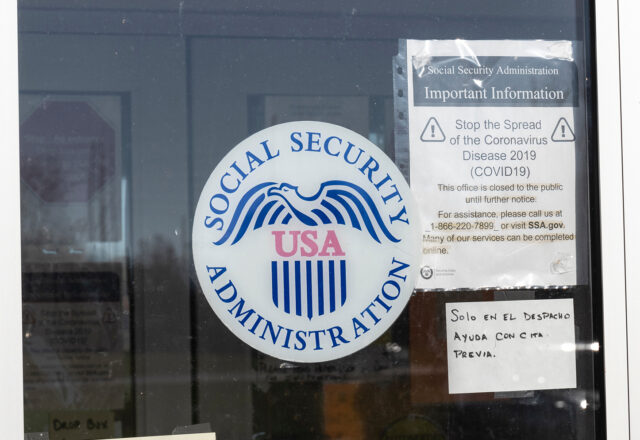
Caregivers Lament Elderly’s COVID Isolation
The magnitude of the tragedy is unfathomable: Americans have lost nearly 187,000 family members living in nursing homes to COVID-19.
Even when residents survive outbreaks in the facilities, their family caregivers experience trauma. Barred from visiting residents during the lockdowns, caregivers observed – on Zoom, over the phone, or from the other side of a nursing home window – loved ones suffering from the devastating impact of isolation.
“To think in her final year[s] when she is most vulnerable and most in need of love and support from her children and was denied this for 6 months is in my opinion devastating,” one caregiver said in a survey of 518 caregivers, the vast majority of them women and mainly daughters.
Granted, nursing homes – and the entire country – were not prepared for a once-in-a-century pandemic that has been difficult to control, given that COVID-19 is often asymptomatic. The lockdowns were a health precaution. Many nursing homes were also put in an untenable position when COVID-19 created staff shortages as nursing assistants and other workers took time off after contracting the disease or simply quit their jobs. And perhaps better communication between nursing home staff and family members would have eased some of the concerns.
Nevertheless, the caregivers’ perceptions of what unfolded inside nursing homes are alarming. “Anger,” “helplessness” and “heartbreak” were common reactions, conveyed in the survey compiled in the Journal of Aging & Social Policy.
The situation became so untenable for 30 of the caregivers surveyed that they pulled their parent or family member out of a facility and brought them home to live with them.
Four themes pervaded their descriptions of what their loved ones were going through: social isolation, cognitive and emotional decline, inhumane care, and a lack of oversight at the long-term care facilities.
The source of many caregivers’ concerns were nursing homes’ decisions to confine residents to their rooms to prevent contagion. But one caregiver said that while her mother’s facility went to great lengths to keep her healthy, the staff did little to ease her isolation: “Almost no effort has been made to ensure [her] mental health due to the isolation. Staff rarely stay and visit with Mom, no special in-room activities or stimulation has been attempted.”
One elderly woman in a nursing home didn’t understand why her daughter couldn’t visit. “She has lost over 41 [pounds] since COVID and now has stopped eating and drinking,” the daughter said. When the mother was referred to hospice, the caregiver was finally allowed to visit. “Why do we have to wait until they are almost dying before we can see them?” she said.
The caregivers said they were usually the residents’ primary or sole source of social interaction. The vast majority visited the nursing home at least once a week and nearly a third went every day. So when the facilities shut down, the residents lost that mental, physical, emotional and social stimulation.
One caregiver was pained by her family member’s decline, which the caregiver witnessed only through a video connection. “She didn’t understand what was happening. She thought she did something wrong. The anxiety and worry cause horrible depression.”
Some caregivers went farther, saying they felt the lockdowns amounted to inhumane treatment. “They are being treated like caged animals,” one said. Said another: “We are saving their bodies and destroying their souls.”
Partly because of the staff shortages in nursing homes, the caregivers often complained there wasn’t enough oversight to ensure that the overworked staff who remained on site were providing their loved ones with proper care.
One man called his daughter in distress. “He called crying he has been calling a nurse and CNA and they would not come to take him to bathroom,” the daughter said. “I cannot even imagine what he went through.”
Another daughter, who could only visit her mother through a glass window, said she wasn’t getting the “consistent routines” required to keep her mentally stimulated. It was “agonizing” to watch her mother’s condition deteriorate.
It took a pandemic for one daughter to realize the nursing home hadn’t been giving her mother all the support she needed. “It became very clear that I was providing at least 20% of my mother’s care in the facility prior to quarantine. She did not get that personal care during quarantine.” Her solution was to bring her mother home to care for her.
But the caregiver for a different nursing home resident took too long to act: “Finally, we took her home and she died 5 hours later with no mention she was at end of life.”
Read more blog posts in our ongoing coverage of COVID-19.
Squared Away writer Kim Blanton invites you to follow us on Twitter @SquaredAwayBC. To stay current on our blog, please join our free email list. You’ll receive just one email each week – with links to the two new posts for that week – when you sign up here. This blog is supported by the Center for Retirement Research at Boston College.
Comments are closed.







Nursing homes, all too often, are “warehouses” for our frail elders. The rare exceptions, often run by religious orders, are to be commended. The solution will not be easy: it will require much more resources put into upgrading the pay and standards for staff at nursing homes and much better support for care at home (where most seniors would prefer to be). How we care for our most vulnerable members says much about us as a society, and it is not pretty.